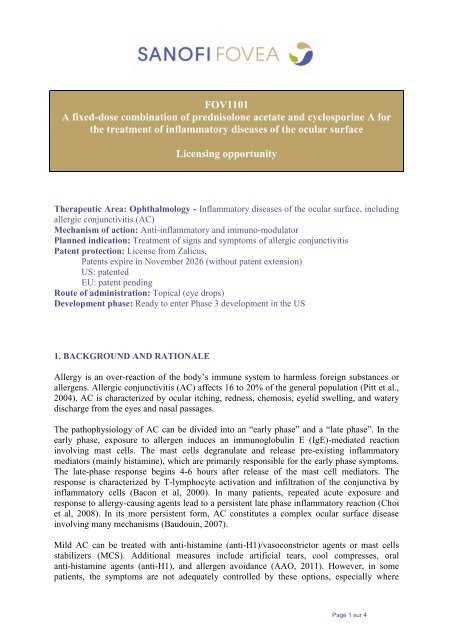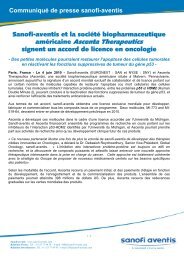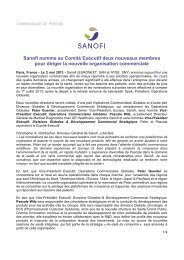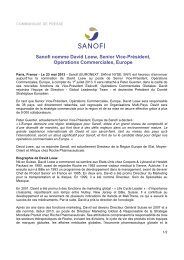FOV1101 Licensing opportunity - Sanofi
FOV1101 Licensing opportunity - Sanofi
FOV1101 Licensing opportunity - Sanofi
You also want an ePaper? Increase the reach of your titles
YUMPU automatically turns print PDFs into web optimized ePapers that Google loves.
<strong>FOV1101</strong><br />
A fixed-dose combination of prednisolone acetate and cyclosporine A for<br />
the treatment of inflammatory diseases of the ocular surface<br />
Therapeutic Area: Ophthalmology - Inflammatory diseases of the ocular surface, including<br />
allergic conjunctivitis (AC)<br />
Mechanism of action: Anti-inflammatory and immuno-modulator<br />
Planned indication: Treatment of signs and symptoms of allergic conjunctivitis<br />
Patent protection: License from Zalicus,<br />
Patents expire in November 2026 (without patent extension)<br />
US: patented<br />
EU: patent pending<br />
Route of administration: Topical (eye drops)<br />
Development phase: Ready to enter Phase 3 development in the US<br />
1. BACKGROUND AND RATIONALE<br />
<strong>Licensing</strong> <strong>opportunity</strong><br />
Allergy is an over-reaction of the body’s immune system to harmless foreign substances or<br />
allergens. Allergic conjunctivitis (AC) affects 16 to 20% of the general population (Pitt et al.,<br />
2004). AC is characterized by ocular itching, redness, chemosis, eyelid swelling, and watery<br />
discharge from the eyes and nasal passages.<br />
The pathophysiology of AC can be divided into an “early phase” and a “late phase”. In the<br />
early phase, exposure to allergen induces an immunoglobulin E (IgE)-mediated reaction<br />
involving mast cells. The mast cells degranulate and release pre-existing inflammatory<br />
mediators (mainly histamine), which are primarily responsible for the early phase symptoms.<br />
The late-phase response begins 4-6 hours after release of the mast cell mediators. The<br />
response is characterized by T-lymphocyte activation and infiltration of the conjunctiva by<br />
inflammatory cells (Bacon et al, 2000). In many patients, repeated acute exposure and<br />
response to allergy-causing agents lead to a persistent late phase inflammatory reaction (Choi<br />
et al, 2008). In its more persistent form, AC constitutes a complex ocular surface disease<br />
involving many mechanisms (Baudouin, 2007).<br />
Mild AC can be treated with anti-histamine (anti-H1)/vasoconstrictor agents or mast cells<br />
stabilizers (MCS). Additional measures include artificial tears, cool compresses, oral<br />
anti-histamine agents (anti-H1), and allergen avoidance (AAO, 2011). However, in some<br />
patients, the symptoms are not adequately controlled by these options, especially where<br />
Page 1 sur 4
epeated acute exposure to allergens –such as dust mites - induces a persistent inflammatory<br />
reaction (Baudouin, 2007). For these patients, topical corticosteroids can be added to their<br />
treatment regimen in accordance with current therapeutic guidelines that recommend the use<br />
of steroids for patients with AC who are not satisfactorily treated with anti-histamine<br />
agents/mast cell stabilizers (anti-H1/MCS). Given the risk of increased ocular pressure (IOP)<br />
and/or cataract formation with steroids, the lowest dosage and frequency of administration is<br />
preferred.<br />
The distinct mechanisms of action of cyclosporine A (CsA) and prednisolone acetate (PA)<br />
provide a relevant rationale for developing a fixed-dose combination (FDC).<br />
- Glucocorticoids, such as PA, are particularly effective in blocking most inflammatory<br />
pathways in allergic reactions, especially those of late-phase mediators that perpetuate the<br />
persistent and chronic forms of ocular allergy (Bielory, 2008).<br />
- Cyclosporine A, a calcineurin inhibitor, is a potent but selective immuno-modulating<br />
agent that has been identified as a potentially effective drug for AC due to its ability to<br />
inhibit the early phase reaction in AC (Sperr et al, 1997; Whitcup et al, 1996) by the<br />
suppression of mast cell degranulation (Shii et al, 2009). Also, CsA was shown to strongly<br />
suppress certain ocular symptoms in late phase and delayed-type reactions in AC models<br />
(Shii et al, 2010). CsA is also effective in controlling ocular allergic inflammation by<br />
blocking Th2-lymphocytes proliferation and IL-2 production (Kari et al, 2010).<br />
Combining CsA with PA is expected to control inflammation associated with AC in an<br />
additive, or even synergistic manner. Therefore, the anticipated efficacy of such a FDC would<br />
be comparable to a high dose concentration of steroid. From a safety perspective, the<br />
combination would allow the cumulative total dose of PA necessary to achieve efficacy in AC<br />
to be limited, therefore potentially reducing the corticosteroid side effects. In addition, the use<br />
of low doses of both CsA and PA would ensure a better local tolerability whilst achieving<br />
sufficient efficacy to control symptoms in AC, and hence achieve a better compliance than<br />
co-administration of separate products.<br />
2. MARKET<br />
The AC market is worth $1.1 billion worldwide (2011) and is dominated by the US. Most of<br />
the value in the US market today is in Rx anti-H1/MCS, with olopatadine (Patanol ® ,<br />
Pataday ® ) as a clear leader followed by more than 10 other products, including the recent<br />
launches (Bepreve ® 2009 , Lastacaft ® 2011).<br />
In the US, the steroids market is largely dominated by loteprednol (Lotemax ® , Alrex ® ), which<br />
represents more than 90% of prescription steroids.<br />
The treatment armamentarium does not fully satisfy the market, with an identified need for<br />
effective treatments for patients who are not satisfactorily treated with anti-H1/MCS, as well<br />
as a need for better-tolerated products than high dose steroids, due to side-effects (e.g.,<br />
increased IOP and/or cataract formation).<br />
The CsA and PA combination would be the first prescription FDC in the treatment of AC.<br />
Page 2 sur 4
3. OCULAR FORMULATION, PHARMACOKINETICS & CLINICAL STUDIES<br />
Formulation<br />
<strong>FOV1101</strong> suspension eye drops are a sterile, preserved FDC of PA 0.12% w/v and<br />
CsA 0.02% w/v in a buffered aqueous vehicle. The product is intended for topical ophthalmic<br />
administration, and is supplied in multi-dose dropper bottles. The <strong>FOV1101</strong> formulation<br />
employs excipients which are commonly used in currently marketed ophthalmic products,<br />
including the preservative benzalkonium chloride at a concentration of 0.01%.<br />
Preclinical pharmacokinetic (PK) studies<br />
<strong>Sanofi</strong>-Fovea has conducted a total of four preclinical PK studies, using CsA alone or with<br />
both components, given as FDC (<strong>FOV1101</strong>) or in co-administration. The studies showed that<br />
PA was rapidly metabolized to prednisolone in vivo, and that both CsA and prednisolone<br />
were found in the target tissues (conjunctiva and cornea) at levels which increased with dose<br />
and over time, whilst plasma exposure was general below limit of quantification. Further, the<br />
PK profiles of PA, prednisolone and CsA were comparable for the FDC and coadministration<br />
in the target tissues, and independent of the individual components.<br />
Clinical studies<br />
<strong>Sanofi</strong>-Fovea conducted a proof-of-concept trial (08-003-27; NCT00833495) in 2009 using<br />
co-administered CsA and PA. This prospective, multicenter, randomized, double- blind,<br />
placebo-controlled study with 150 patients was conducted in the USA utilizing Ora′s<br />
Enviro-CAC clinical technology. The co-administration of low doses of CsA and PA was<br />
compared to PredForte ® alone or vehicle alone during a 2-week dosing period.<br />
Co-administration of CsA and PA had the same efficacy and a better safety profile (no<br />
increase in IOP) than PredForte ® , a prescription drug with an 8-fold higher dose of PA, in<br />
patients treated for the signs and symptoms (itching and redness) of persistent ocular allergic<br />
inflammation (non responding to 1-week pre-treatment with Pataday ® ).<br />
<strong>Sanofi</strong>-Fovea also conducted, in 2010, a prospective randomized, double-blind placebocontrolled<br />
Phase 2b trial (10-003-03; NCT01120132). The purpose of this study was to<br />
determine the efficacy and safety of the administration of CsA and PA compared to placebo<br />
in the treatment of allergic conjunctivitis, using diary and office assessments of various ocular<br />
and nasal allergy signs and symptoms. This 28-day study enrolled 716 patients in the US.<br />
This clinical data package provided key information to design the Phase 3 program that will<br />
be conducted with the FDC product.<br />
4. OCULAR SAFETY PROFILE<br />
For each active substance of the FDC, CsA and PA, there is extensive nonclinical and clinical<br />
safety information available in the literature. The toxicity of CsA has been widely studied<br />
during the development of various pharmaceutical forms for the treatment of systemic or<br />
ophthalmic diseases, whilst that of prednisolone (the active metabolite of PA) is described in<br />
published studies. Summaries of the main findings can be found in the prescribing<br />
information, labels and/or NDA pharmacology reviews of Sandimmune ® and Restasis ® for<br />
CsA, and in the prescribing information for Orapred ODT ® and Pred Forte ® for PA.<br />
For both active substances of the FDC that are given by ocular instillation, the systemic levels<br />
of exposure are estimated to be several hundred-fold lower than the levels encountered after<br />
Page 3 sur 4
oral or parenteral administration. Specifically, blood CsA levels are >600-fold higher in organ<br />
transplant patients than for dry eye patients given eye drops of Restasis ® 0.05% emulsion<br />
(which is 2.5 times more concentrated in CsA than <strong>FOV1101</strong>), and prednisolone plasma<br />
levels have been predicted to be >400-fold higher for patients taking a 30-mg oral dose than<br />
for those to be treated with <strong>FOV1101</strong>.<br />
<strong>Sanofi</strong>-Fovea has conducted a series of local tolerance/toxicity studies of the topical<br />
formulation in rabbits, either with the combination of CsA and PA, or with CsA alone. From<br />
these nonclinical studies and in particular a 6-week safety rabbit study performed with topical<br />
ocular administration of CsA and/or PA compared to vehicle, no overt local or systemic<br />
toxicity effects are to be expected in patients treated with <strong>FOV1101</strong> eyedrops QID for up to<br />
6 weeks due to the low dose levels of the drug substances given locally and the subsequent<br />
low systemic exposures<br />
5. VALUE PROPOSITION<br />
<strong>FOV1101</strong>, through its dual mode of action, represents a new potentially safe therapeutic<br />
option for AC patients who cannot be relieved from their persistent inflammation with current<br />
available treatment. In addition, the use of low doses of both CsA and PA would ensure a<br />
better local tolerability while achieving sufficient efficacy to control symptoms in AC, and<br />
hence achieve a better compliance than co-administration of separate products.<br />
6. REFERENCES<br />
American Academy of Ophthalmology (AAO). Cornea/External disease panel. Preferred Practice Pattern<br />
Guidelines. Conjunctivitis. Limited Revision 2011. San Francisco, CA. American Academy of Ophthalmology.<br />
Bacon AS, Ahluwalia P, Irani AM, Schwartz LB, Holgate ST, Church MK et al. Tear and conjunctival changes<br />
during the allergen-induced early- and late-phase responses. J Allergy Clin Immunol.2000;106(5):948-954.<br />
Baudouin C. Conditions bordering on allergy. J Fr Opthalmol.2007;30(3):306-313.<br />
Bielory L. Ocular allergy treatment. Immunol Allergy Clin North Am. 2008;28(1):189-224, vii.<br />
Choi SH, Bielory L. Late-phase reaction in ocular allergy. Curr Opin Allergy Clin Immunol. 2008;8(5):438-444.<br />
Kari O, Saari KM. Updates in the treatment of ocular allergies. J Asthma Allergy. 2010;24;3:149-158.<br />
Pitt AD, Smith AF, Lindsell L, Voon LW, Rose PW, Bron AJ. Economic and quality-of-life impact of seasonal<br />
allergic conjunctivitis in Oxfordshire. Ophthalmic Epidemiol. 2004;11(1):17-33.<br />
Shii D, Oda T, Shinomiya K, Katsuta O, Nakamura M. Cyclosporine A Eye Drops Inhibit the Early-Phase<br />
Reaction in a Type-I Allergic Conjunctivitis Model in Mice. J Ocul Pharmacol Ther. 2009;25(4):321-328.<br />
Shii D, Nakagawa S, Yoshimi M, Katsuta O, Oda T, Nakamura M. Inhibitory effects of cyclosporine a eye drops<br />
on symptoms in late phase and delayed-type reactions in allergic conjunctivitis models. Biol Pharm Bull.<br />
2010;33(8):1314-1318.<br />
Sperr WR, Agis H, Semper H, Valenta R, Susani M, Sperr M, et al. Inhibition of allergen-induced histamine<br />
release from human basophils by cyclosporine A and FK-506. Int Arch Allergy Immunol. 1997;114(1):68-73.<br />
Whitcup SM, Chan CC, Luyo DA, Bo P, Li Q. Topical cyclosporine inhibits mast cell-mediated conjunctivitis.<br />
Invest Ophthalmol Vis Sci. 1996;37(13):2686-2693.<br />
6. CONTACTS<br />
Guy Claude Anne Marie SIGOT<br />
Vice President Out-<strong>Licensing</strong> &Special Projects Senior Manager Out-licensing and Special Projects<br />
Strategy & Business Development Strategy & Business Development<br />
Corporate Licenses Corporate Licenses<br />
Guy.claude@sanofi.com Annemarie.sigot@sanofi.com<br />
Page 4 sur 4







